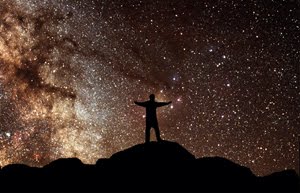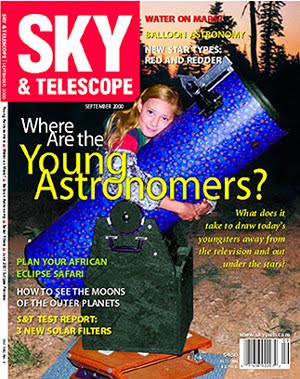Each season brings a new feeling to observing at Fremont Peak. The change of temperature, color of sky and earth, the look and number of observers, the piece of our universe on the menu, all add up to distinct flavors. Each season is to be enjoyed, savo red like a good slow, favorite meal spent with friends lost in interesting conversation.
This Sunday I spent at the Peak was the winter solstice. The longest night of the year. Everything from the drive up to the conditions at the Peak set it apart from any other night of the year. On the way out of town, I found traffic to be minimal, sin ce the masses were probably heading home from their Christmas shopping, and the clear skies and brisk breezes made it feel unseasonably cold for the first day of winter in northern California. My favorite part of the hour-long drive is that up San Juan C anyon Road, which is the turnoff from highway 152 east at the historic pueblo of San Juan Buatista. A few short turns off the main highway brings to view sheep, with their coats growing thick, cows huddled together against the wind, horses in shelters, g oats, and assorted non-domesticated wildlife on the ground and in the air. The oaks were all hanging with the Spanish Moss I had first seen at Point Lobos twenty five years ago. The moss will be here much longer than I.
Everywhere I looked on the drive up, the earth seemed to be pulling in its growth, like someone tucking their hands and feet into a nice warm blanket. Our orbit around our local star was bringing a more rugged time of the observing calendar to my part of the world. Still, I had done it before, and was prepared for what many, in colder climes, would laugh at, and dream of, a California winter. Still, for someone who has lived most of his life on the southwest shores of the United States, winter is cold, if only by local standards.
The drive up gave a message of caution for the drive back, which I planned for about midnight, since I had to work Monday morning. In the shady part, and the wet portions of the road, road crews had spread sand. Temperatures were now dipping below freez ing in the area, and this was not anywhere near the elevation of the Peak. After entering the park, I looked up to my right to find Alan Nelms, my observing partner, waving from up on Coulter Row. He looked like he was doing some odd dance. The trees w ere all bare, the grasses of spring and summer gone. I pulled into to observing site and got out of the truck. Alan immediately told me the temp was 41 degrees when he arrived, and felt even colder now. Up above us on the ridge line, branches of the oa ks were swaying in the wind, but we were somewhat protected down in our area. Usually, we avoid Coulter Row because of the traffic and headlights on weekend nights, preferring the less trafficked southwest lot. But this was Sunday, and headlights were no problem after about 8 p.m.
Looking around, I began unloading the scope, and noticing what Alan then commented on. Wild pigs had torn up the bare earth all along the downslope below Coulter Row. These are the same swine the park service hopes to keep out by erecting a fence aroun d the park (perhaps next year). Soon, Alan had his 18" and I had the 14.5" dob set up and collimated. We began to notice the chill and the tranquility of winter at the Peak.
Soon, a Spanish speaking family hiked up the hill to meet us. I gave them views of Venus' crescent, a small reddish Mars sitting very close by, then up to Jupiter. The tourists were astonished to be able to view foreign worlds, seeing details such as ba nding and moons. It is always a rewarding experience seeing another person's universe suddenly expand.
The temps began dropping, and I was not bundled in much of my cold weather gear. Alan was putting on his ski bibs. A car full of day visitors drove by slowly, looking at us as if we were space aliens. I am sure they wondered what Alan was doing, standi ng there with his "pants" (ski-bibs) down around his ankles. Must have thought we were some deviants. Another TAC member, Robert Dannels (?) appeared, and decided to move from the breezy southwest lot to where we were. And that was it for the night. T hree TAC members alone on Coulter Row, atop Fremont Peak, on the longest night of the year. Only the appearance of Jay Freeman late in the evening would alter the makeup of our small winter observing party.
I began the night observing Jupiter and Saturn under low power. I did not think much of the observing conditions, but for the faint fuzzies Alan and I were hunting that night, somewhat soft seeing was not a disaster. So, we hunted down NGC 253 to begin the night, then it was off to the races. We hit a few big galaxies in Sculptor, part of the Herschel 2514, and had to leave the constellation unfinished, perhaps until some all nighter in summer, as the earth's rotation soon put it down toward the mounta in and into the increasing light dome of Salinas.
So, we moved up into Cetus. Again, our quest was difficult, since we had already logged most of the Herschel's in that constellation, above mag 14.5. We found a few, and then headed for the fertile waters of Eridanus, the River.
Eridanus is without doubt one of my favorite places to poach photons. The area is teeming with galaxies. Some big and bright, others mere near-stellar smudges. Most are off in the void, away from many finder stars, making one work at seeing fainter and fainter naked eye targets with which to navigate to the proper eyepiece field. This is why I do not use DSCs. The hunt, the perfecting of naked eye star hopping, the testing of visual acuity, and the increased skill that follows, is all part of amateur astronomy for me. Many are the objects that are really no more than a hint at the threshold of vision, but it is the hunt, and the reward when an object shows distinct character, structure, or is in a massive field of island universes.
The galaxy hunting was extremely rewarding early on, in Eridanus, with many large objects and multiple finds in one field, or near the original targets. A few of the more impressive sights were NGC 1600, accompanied by closeby NGCs 1601, 1603, 1604, 1594 , 1611, 1612, 1613 and IC373. Also, NGC 1653 had NGCs 1654 and 1657 nearby. There were several very large ESO galaxies in the area, but they were out of range for this particular night. Usually, Alan and I would have a chance finding them. It is great to observe with an accomplished fuzzy hunter like Alan, since there are times when he can identify something that I overlook, and vice-versa. Double teaming the universe! But, on the winter solstice for 1997, the sky changed personality rather quickly. One minute Alan and I were popping faint fields of galaxies at will, then, after a quick check of the computer for another target, we both were back at our eyepieces when, I looked at the out of focus stars and began trying to focus them. I couldn't ge t them to pinpoints. It quickly dawned on me the sky conditions had gone completely soft. Just then Alan said "the sky just went" and I laughed out "yeah.... I've been trying to focus" and he said "me too!". We played with fields full of planetary nebu lae type stars for about an hour and a half, then I said let's pack it in, since we'd already had over 5 hours of observing, and this night of all was the least likely for an all-nighter.
I packed up the scope quickly and helped Alan with his. It was tough to bend down to lift the Obsession. I had on jeans, the bottoms of my gore-tex ski suit and a pair of sweat pants, three layers of socks and Sorrels, a heavy long sleeve shirt, rag woo l sweater, lined wind-breaker, down jacket, large ski-jacket, neck gator and Soviet Ushanka hat. I was not cold, but I was not very mobile. :)
When we finally got ready to roll out just after midnight, the temp was 34 degrees. The sky looked deceivingly calm. Only under magnification can one see the turmoil nature hid in winter's longest night.
The ride home was uneventful, and the night enjoyable. I look forward to other good sessions in the season of cold skies.











